Around the Neighborhood - Volume 1, Number 3
In 1973, Family Communications initiated a print newsletter titled Around the Neighborhood. This newspaper-like publication was largely directed towards parents but included some material for children as well. The information below documents the third issue.
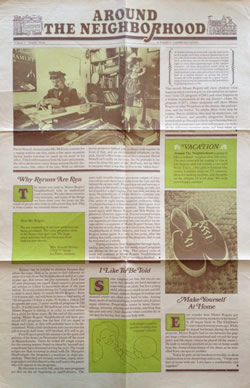
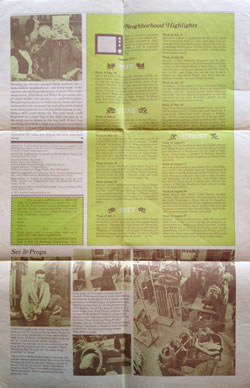
[click images for larger view]
Articles included:
- "David Newell in his office"
- Why Reruns Are Run
- I Like To Be Told
- Vacation
- Make Yourself at Home
- "Dressing up"
- Neighborhood Highlights
- Set & Props
Articles
David Newell, dressed in his Mr. McFeely costume for a taping session one day, takes a few spare moments during studio rest-time to catch up on work in his office. Filled with treasures from the past and present, the office shows how many things interest David; theater, music, film, relics of the past.
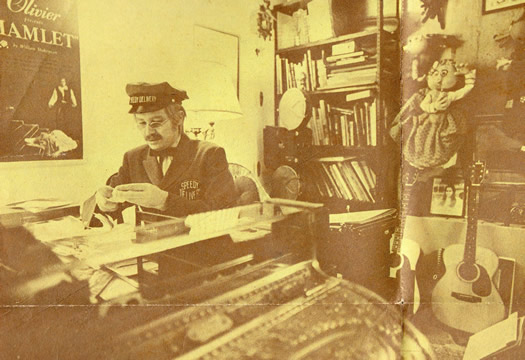
With an old-time movie projector behind him, a classic cash register in front of him, and an old-fashioned telephone on his desk, David's office looks almost like a museum. David Newell isn't really an old man, like he pretends to be when he plays the part of Mr. McFeely, but he likes to imagine what it was like to live in the "olden days."
The letters you send to Mister Rogers' Neighborhood help us understand your concerns. We take these concerns very seriously, and many of the things we have done over the years are the result of people who write to tell us how they feel. This is from a letter we received about reruns:
Dear Mr. Rogers:
We are wondering if any new programs are being produced. The same programs seem to be shown over and over. We hope other activities will not keep you from making new shows.
Mrs. Donald Hickey
La Porte, Indiana
Reruns can be helpful to children because they allow the same child as he grows to find different aspects of a visit from the Neighborhood useful at a particular age. But reruns are also necessary. Each year 65 new programs are taped. Each season's programs are written to follow in succession those of the year before. To avoid reruns during the 3 year period when a child is most likely to watch Mister Rogers -- from 3 to 6 years old -- we will have to have a total series of 780 programs (5 days a week, 52 weeks a year is 260 programs per year; 3 years' worth of programs is 780 in all). It is this total of 780 half-hour color shows that Mister Rogers is aiming at in order to avoid reruns for a child for three years. By the end of this season's taping, Mister Rogers' Neighborhood will have produced 455 programs, but the first 130 ar taped in black and white, so they will probably have to be discontinued. With a little arithmetic you can see that the job is exactly half done: 455 finished, 455 still to go.
Fred Rogers spends his summers in the quiet and privacy of his home on Nantucket Island off the coast of Massachusetts. There he writes 65 rough scripts for the coming season, based on the ideas he, his staff and consultants have discussed during the year. The rough scripts are then reviewed in detail with Dr. Margaret MacFarland [sic], the program's consultant in child psychology. Then they are reviewed, rewritten, typed, mimeographed and distributed to the staff and to the guests who will appear in the programs.
By this time it is early fall, and the new programs are due on the air beginning in mid-February. The next eight months demand enormous output of creative energy and sheer hard work from the cast and the behind-the-scenes staff. Preparing a set and moving it into place in the studio is time-consuming, so only one set is used for a day's taping. For instance, we may do three Neighborhood of Make-Believe segments one day, two Mister Rogers' house segments another day. One seven or eight minute segment ordinarily takes 2 1/2 hours because it is first rehearsed, then taped, then viewed on the television monitor, then frequently taped again until Mister Rogers and Bob Walsh, his producer/director, approve it. It is not unusual to tape a segment 3 or 4 times before it is accepted. The various segments are then meshed into one another by the tape editor -- a segment of Mister Rogers' house, then the bakery or soda shop, back to his house, then to the Neighborhood of Make-Believe, and back to Mister Rogers' house again. It is only at this point, after the editing has really constructed the program, that it can be reviewed as a whole.
Taping continues from September through April, ending just before the last few newly-taped programs are shown on the air in May. This annual cycle of work will continue at Mister Rogers' Neighborhood until the whole series of 780 programs is finished.
Some surprises are fun, but shocks are never fun. Shocks are hard enough to cope with as an adult, but for a young child, who sees so much as new and different, sudden changes in routine and unusual events are often very hard to take. Among them, medical and dental visits, even hair cuts, frighten many children. Preparation comes in many forms: talking, listening, playing and drawing, anything that lets you and your child discover what concerns he or she may be having that you can help with.
A dentist poking around with a probe that looks as if it might stick him; a doctor hooked up to an icy cold stethoscope, listening with a very serious look on his face; an eye doctor bringing a bright light so close that squinting tight is the natural reaction -- all these procedures could easily be previewed in your own living room. Letting your child perform some play procedures on you or a doll or a stuffed animal, or acting the whole drama out with puppets, can be a great beginning at mastering the unknown or the potentially frightening times of life.
This month Mister Rogers will show children what happens when a person goes to a hospital for an operation (June 25, program #286) and what happens in a routine examination at the eye doctor's (June 26, program #287). Other programs will show Mister Rogers or other Neighbors at the dentist , the pediatrician, and the barber. To adults, these visits may be routine. But to children, they may be mysterious, out of the ordinary, and possibly dangerous. Seeing a trusted adult go through a check-up or hearing him explain with reassurance just what will happen can make all the difference between panic and trust when appointment time comes.
Around the Neighborhood is going to take a summer vacation after this issue. The next issue will be coming to you in late August, and will include a visit with Nick Tallo, a Neighbor behind the scenes, a picture story on TV cameras, ideas for making mobiles, and thoughts on the delights of word play. We wish you a happy summer!
Ever wonder how Mister Rogers got started wearing sneakers in his house? It all began back in The Children's Corner almost twenty years ago. While he stayed backstage during the 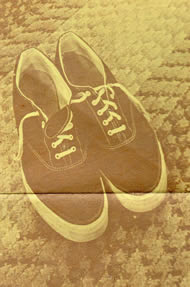 whole program, Mister Rogers had to run between the puppet stage (where he manipulated and voiced the puppets) and the organ (where he played all the music). He took to wearing sneakers so no one at home could hear the clomp-clomp-clomp of his shoes as he traveled from one spot to another.
whole program, Mister Rogers had to run between the puppet stage (where he manipulated and voiced the puppets) and the organ (where he played all the music). He took to wearing sneakers so no one at home could hear the clomp-clomp-clomp of his shoes as he traveled from one spot to another.
Today he puts on his sneakers every day to show children how to tie shoestrings and to say, "I hope you feel at home with me. Let's have a comfortable visit together."
Dressing up can turn anyone's home territory into a make-believe neighborhood, and home-made masks can turn any child into the beauty or beast of his or her imagination. Elsie Neal and Mister Rogers make simple paper masks with one piece of construction paper. 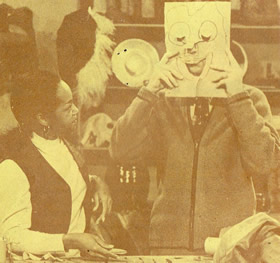 Designs can be drawn on with crayons, noses and eyes and mouths torn out or cut out, and parts can be folded in or out to make the face of just about anyone or anything a child might dream up. The same mask could be pasted on a paper bag so the child can wear it, or the mask can be drawn on the bag itself. A new face can bring out a lot in a child, too, a lot you never knew was there. Listen to what the creature has to say when your own child's mind is working behind it and try to remember the times you played out such important things.
Designs can be drawn on with crayons, noses and eyes and mouths torn out or cut out, and parts can be folded in or out to make the face of just about anyone or anything a child might dream up. The same mask could be pasted on a paper bag so the child can wear it, or the mask can be drawn on the bag itself. A new face can bring out a lot in a child, too, a lot you never knew was there. Listen to what the creature has to say when your own child's mind is working behind it and try to remember the times you played out such important things.
Note: If you miss a program that you or your child is particularly interested in, check with your local station to see when it will be repeated. Give them the program number.
Summer 1973
Week of May 28:
This is the week of the waterfall. Monday (#266) the king decides he ought to have a waterfall behind the Castle, and that decision brings on a whole series of adventures. Tuesday (#267) the waterfall leaks into the gymnasium, where the king is exercising, and gets him all wet. Francois Clemmons visits the Neighborhood of Make-Believe Wednesday (#268) and sings an aria beside the waterfall. Back in Mister Rogers' Neighborhood, Bob Trow helps Mister Rogers build an electric fountain on Thursday (#269).
Week of June 4:
Bob Dog fetches a letter for Dr. Bill in the mail Wednesday (#273) and mistakenly tears it -- a mistake that is hard to admit. Friday (#275) Dr. Bill and the Platypus family leave for Australia, assuring the Neighbors of Make-Believe they will return soon.
Week of June 11:
Lady Elaine rebels against the traditional request of "QUIET PLEASE" and puts up her own sign, "NOISE PLEASE" on Monday (#276). When no players show up at Betty's Little Theater Wednesday (#278), she and other neighbors play make-believe instead. Friday, Bob Dog forgets to deliver a message for King Friday, and learns that even though the king is mad with him, he is still well-loved as the Neighborhood dog (#280).
Week of June 18:
Tuesday (#282) Joe Negri shows Mister Rogers the guitar he has made. In Betty's Little Theater on Wednesday (#283), children act out nursery rhymes. Thursday (#284) Yoshi Ito sings a Japanese song, and Lady Elaine tries to capture her voice in a paper bag.
Week of June 25:
Monday (#286) Mister Rogers shows a film of himself going to the hospital to have a throat operation. The next day (#287) he and Henrietta both have appointments with the eye doctor. Thursday and Friday (#289 & #290) Mister Rogers and Francois Clemmons try on some costumes Francois brought from the Metropolitan Opera.
Week of July 2:
The Browns move into the house next to Mister Rogers Wednesday (#293) and show him their puppet theater equipment. Thursday Ezra Jack Keats talks about writing a book, and book editor Brenda Joyce talks with the Neighbors of Make-Believe about some of the many professions a woman can have. Friday the Brown Puppet Theater puts on "Jack and the Beanstalk" (#295).
Week of July 9:
This week is spent in preparation for the opera, called "The Uncle of the Monkey," which takes place in a zoo. John Reardon of the Metropolitan Opera Company visits and helps the Neighbors of Make-Believe dress up for the big production on Thursday (#299). Chef Brockett is the monkey's uncle!
Week of July 16:
Tuesday (#302) Henrietta disappears, and the other neighbors learn that she is afraid of meeting Susan Linn, a visitor in the Neighborhood of Make-Believe. A kite that looks like a witch scares Daniel and Bob Dog Thursday (#304), and Friday they use the kite to try to frighten the king. Mister Rogers talks about how pretending sometimes can make things less scary.
Week of July 23:
Grandpere's granddaughter Colette comes from Paris to visit the Neighborhood of Make-Believe on Wednesday (#308), and her expected arrival makes Henrietta worry that with this glamorous newcomer no one will care about her any more. By Friday (#310) she has learned that Colette can be a friend.
Week of July 30:
When X the Owl is hit by Lady Elaine's teeny, tiny hardball Tuesday (#312), Corney can't understand why X starts to cry. Corney soon learns, though, on Wednesday (#313), when he hurts himself on his new lathe. Everyone cries sometimes, when something hurts. Thursday (#314) Eric Kloss, a blind jazz saxophonist, visits Joe Negri's Music Shop. Mister Rogers compares jazz music Friday (#315) with a different kind of music.
Week of August 6:
Monday (#316) the Browns share homemade puppets with Mister Rogers. Pictures of parents drawn by children are shown on Wednesday (#318), and in Make-Believe King Friday is delighted to find that his baby son, Prince Tuesday, finally recognizes his father's face and smiles.
Week of August 13:
When the King upstages Lady Elaine's book show Monday (#321), she spitefully turns the Neighborhood of Make-Believe upside down until all the Neighbors come to the Museum-Go-Round. Van Cliburn visits Tuesday and Wednesday (#322 & #323). Lady Elaine learns that she can't force anyone to spend time with her, but is happy to find that Handyman Negri chooses to stay on Thursday (#324).
Week of August 20:
Mister Rogers visits Betty's Little Theater Monday (#326), where she and Mary Sweenie practice dancing like birds. Wednesday is Poetry Day in the Neighborhood of Make-Believe and all the neighbors read poems they have written if they want to (#328). Bob Trow has to practice to learn to ride a bicycle Friday (#330) because he never learned when he was a child.
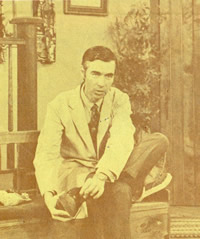 Week of August 27:
Week of August 27:
Thursday Corney carelessly pours some left-over wood stain into the Creek (#334) and not only stains his waterwheel but also pollutes the King's waterfall. Luckily Lady Elaine can repair it by boomerang magic in the make-believe world. Mister Rogers talks Friday (#335) about how things and people sometimes get dirty in the real world but can't be cleaned up by simple magic.
A television studio is like a big, empty room. For the studio to look like the house you see Mister Rogers in every day, many people have to work hard to build walls, doors, windows, and furniture which make up the "set." Little things like plants, curtains, a telephone, the fish tank, have to be carried on the set so that the house looks like a real place. These little things that "dress the set" are called "stage properties" or "props."
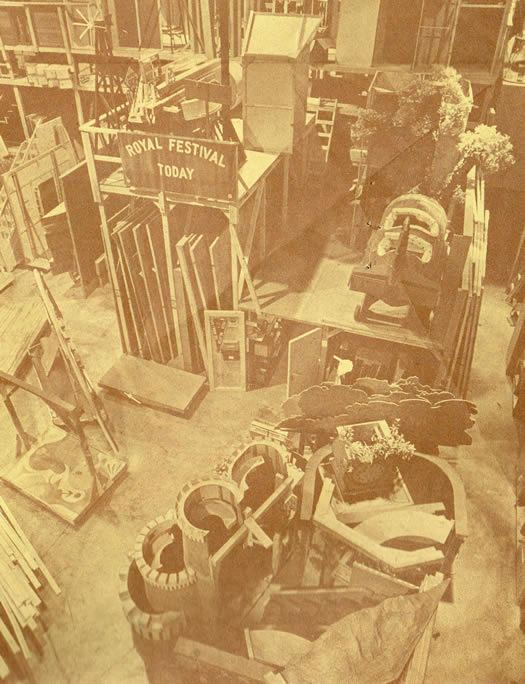
Take a look at Mister Rogers in his living room and look for different parts of the set. Do you see the walls, the door, the window, the rug? These are all parts of the set. Now do you see any "props" that Mister Rogers is using? There is a seashell sitting next to him on the bench. That is a special prop for his particular visit.
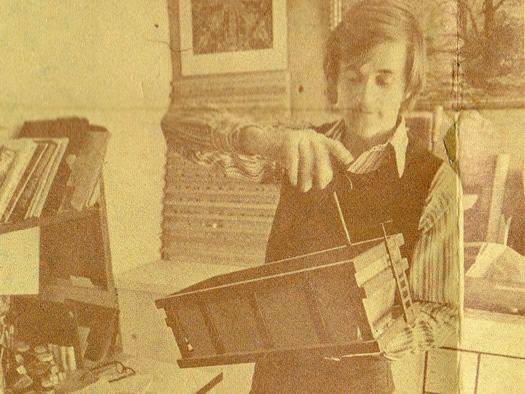
Some props can be bought or found, like the seashell. Others people have to make especially for the program. In this picture, Dave Smith, associate art director in Mister Rogers' Neighborhood puts together a potato train for the Neighborhood of Make-Believe. And below, men are working on a much bigger prop: King Friday's airplane. All the sets and all the props are stored in a large room near the studio. Just look at all the things you can find there! What do you see? King Friday's airplane, and the banner from the Festival of Mad Feelings? Can you find Daniel's Clock? And next to the Clock, the round towers of a certain Make-Believe castle!
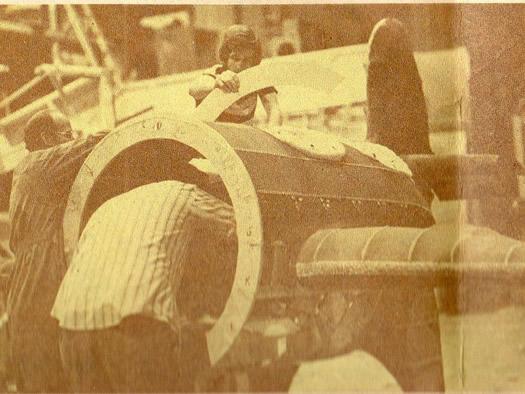
Credits
Around the Neighborhood and the materials that accompany it are published ten times a year by Family Communications Inc., a not-for-profit Pennsylvania corporation.
Around the Neighborhood is created for FCI by Media Projects Incorporated of New York.
Executive Editor: Sara Stein
Editor: Susan Tyler Hitchcock
Editorial Staff: Hedda Sharapan, Mary Gale Moyes
Graphic Designer: Tobias O'Mara
Editorial Consultants: Petty Wright, Dick Whittingham
© 1973, Family Communications Inc.
